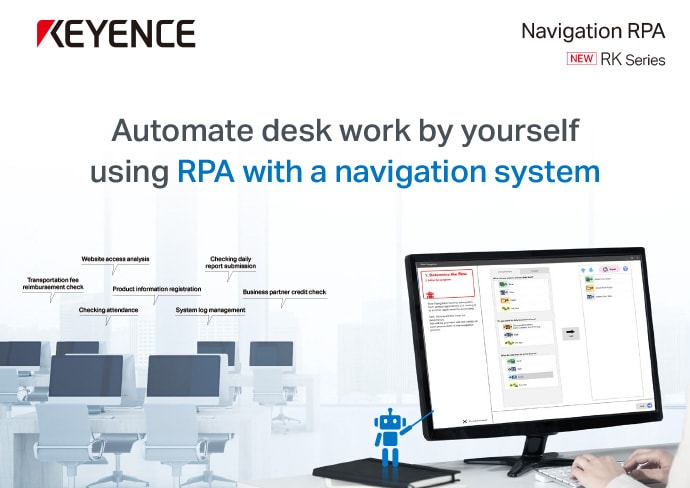Fuyo General Lease Co.,Ltd.
RK has been implemented and is currently being expanded across 18 departments. Moving forward, we plan to increase the number of departments, including sales, to further promote the automation of more operations.
Fuyo General Lease Co., Ltd. has introduced KEYENCE's RPA (business automation) tool, RK, to achieve automation through end-user computing. We successfully expanded its use across 18 departments centered on the corporate division, leading to widespread adoption. We spoke in detail with Mr. Kashiwara, the section manager of the System Planning Department leading RK promotion, Mr. Setoguchi, the section chief, and Mr. Tabata about the background of RK's implementation, its current utilization, and tips for expansion.
Fuyo General Lease Co., Ltd.
Fuyo General Lease Co., Ltd. is a major domestic leasing company with a diverse portfolio including information equipment, medical devices, and facility equipment. Recently, to address social issues, the company has expanded into new business areas beyond leasing, such as renewable energy power generation, mobility, and BPO services. Under the slogan "To Unprecedented Places," the company is pursuing management aimed at solving social challenges while simultaneously enhancing corporate value.
- Established: May 1, 1969
- Capital: $72.6 million
- Employees: 860 (individual), 3,803 (consolidated) (as of the end of September 2024)
- Annual Revenue: $4.9 billion
Utilizing RK for automating operations across 18 corporate departments
Please tell us about the current status of RK utilization.
RK is mainly used to automate tasks within the "corporate departments" such as the Finance Planning and Management Planning departments. Currently, there are 74 scenarios (automation programs). Specifically, most of the work involves "monthly data management tasks," such as transferring data from other systems into a "department-wide management sheet" or copying data from the management sheet to other files. Additionally, tasks like processing stock ownership data and managing reservations for employee welfare facilities—tasks that only a limited number of employees can handle,—have also been automated using RK.
Creator licenses are allocated based on the level of utilization by each department, with some departments not holding any dedicated licenses. The runtime licenses are assigned to 11 departments where scenarios are actively running, with one license per department. Moving forward, licenses may increase or decrease depending on the development progress and scenario completion status. In this sense, the subscription-based monthly contract system is very convenient.
Aiming for development through end-user computing
Please tell us about the background of RK's implementation.
Before adopting RK in 2023, our company had been automating tasks using another company's RPA since 2019. The automation mainly involved "business departments" inputting hundreds or thousands of data entries daily into core systems. However, this RPA was server-based, excelling in high-speed processing but difficult for end-users to handle for applicable development and operation. To use it, we needed to dispatch several on-site staff from the vendor for daily development and troubleshooting.
Meanwhile, there was a growing discussion about automating PC-based tasks unique to each department using RPA. However, the previously used third-party RPA was not suitable for end-user automation, as mentioned earlier. Relying on vendors for every small PC task automation would cause delays and be cost-ineffective. Therefore, we started considering new RPA solutions.
After several months of comparison and evaluation in the first half of 2023, we chose RK for multiple reasons. We initially contracted about 10 licenses as a trial in the second half of 2023. After using it for several months and experiencing its ease of use and potential for end-user computing, we decided to proceed with full-scale implementation.
What are the reasons for selecting RK over competitors?
The main four reasons are:
- Robust support system
- Rich selection of features and high activity functionality
- Frequent version updates
- Subscription-based pricing model
The most significant factor was the support system. Even though it was free, having dedicated personnel who respond immediately to questions was very enticing to us.
What four strategies did you implement to promote RK within the company?
As automation progresses across each of the 18 departments, the expansion within the company is also advancing. What strategies did you implement to promote RK's widespread adoption internally?
We employed the following strategies:
- Gaining understanding from management and having them oversee the promotion and production implementation
- Providing RPA development challenges to facilitate learning
- Creating champions and leaders within each department
- Holding workshops for enhanced learning opportunities
Gaining management understanding
Even in a bottom-up approach, it’s crucial to secure understanding from top management, especially since licensing involves cost. Before starting RK trials, we gathered vice presidents and executives, demonstrated simple scenarios created on the spot with RK, and highlighted the tool’s ease of use. This approach led to management giving the green light to proceed.
Providing development challenges for learning
RK promotion is mainly handled by Mr. Setoguchi and Mr. Tabata. With a small team, conducting training sessions for each new user would be unsustainable. Instead, we set "challenges" to help users acquire RK skills. First, users learn basic operations via the extensive support site provided by KEYENCE, then create scenario tasks based on given themes. If their work meets the passing criteria, they are officially granted licenses.
Creating champions in each department
For license distribution, we appointed two "champions" per department—one leader and one deputy—to promote RK and serve as contact points for system planning. Departments with active champions tend to utilize RK more broadly, which has proven very effective.
Holding workshops
We hold "RK workshops" every two months for champions in each department to share the latest updates and improve skills. These sessions include explanations of version upgrades and case studies from other departments. KEYENCE support staff also participate, providing timely insights and advice, making these workshops valuable.
By bringing users together in these workshops, we aim to foster active communication and eventually enable problem-solving among "RPA colleagues."
The ongoing support is highly valued for its reassurance and stability
Please share your evaluation of the ongoing support.
It provides a sense of security and stability. Responses to questions are accurate, and inquiries via email are answered promptly. We also appreciate that support staff communicate in simple, user-friendly language, even for those with lower IT literacy.
Additionally, during a workshop, when we discussed using RK for web scraping to retrieve specific data, support staff added, "The retrieved data can also be attached to emails," which was very helpful. Their understanding of the workshop's purpose and their willingness to provide such clarifications are greatly appreciated.
Achieving a reduction of 433 hours in work hours
Please tell us about the effects of RK.
Quantitatively, from the second half of 2023 to the first half of 2024, we reduced approximately 847 hours of work from an estimated 1,661 hours, achieving a 51.1% reduction rate. The benefits of RK extend beyond just saving time; it also improved the original Excel items and reduced the need for manual transcriptions, leading to better organization and review of operations.
Furthermore, as the "scenario specification" documents are developed within the system planning department, we expect to see reduced dependence on individual knowledge, easier sharing, management, and refinement of scenarios, and a decrease in "black box" or rogue scenarios.
RK as a "partner" in your work
What kind of presence does RK have for you?
While not exactly a "copy" of myself, RK is close to that. Just pressing a button allows it to handle my tasks, which is very much like a "partner." From the perspective of workflow improvement, I also see RK as a "partner."
What are your future plans for RK?
Our immediate goal is to enable all 18 departments currently using RK to run scenarios, as only 11 are active now. We also aim to increase the number of scenarios to improve cost-effectiveness. Additionally, we want to expand RK usage beyond the corporate departments to business units. Currently, other RPA tools used in business units are optimized for high-speed processing of large volumes, but we hope to use RK for more routine, smaller tasks.
We are also considering creating a library of reusable "sub-scenarios" to facilitate sharing and standardization. For example, sales departments across different locations perform similar tasks, so developing reusable scenarios would be highly beneficial.
To realize these plans, we hope to leverage KEYENCE’s support and will continue to frequently update RK and support ongoing information exchange.

Navigation RPA RK Series
View Catalog
